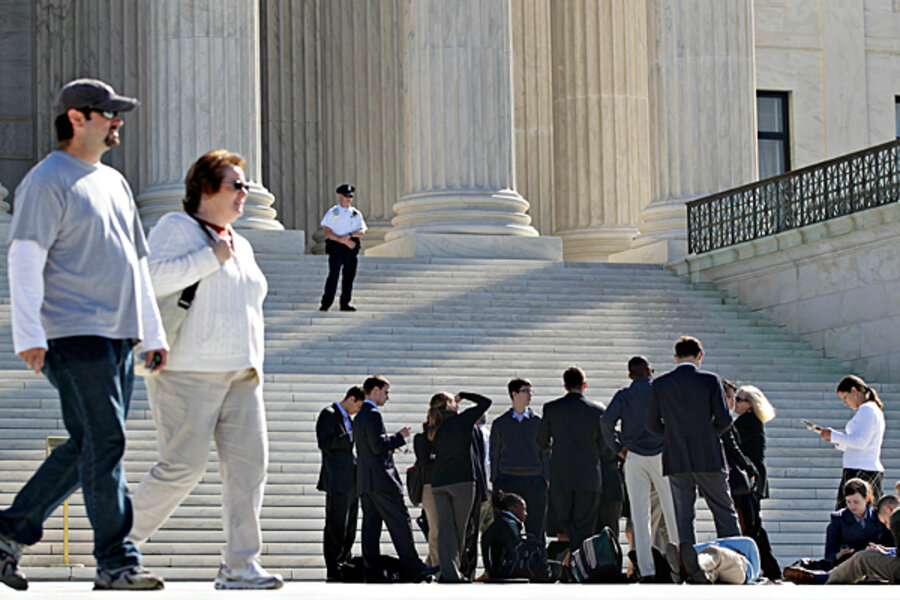Should eye witnesses have to pass a test? Supreme Court to decide.
Loading...
| Washington
Most folks believe there is nothing better to solve a crime than an eye witness. Ironically, according to criminologists, eye witnesses can be notoriously unreliable and easily influenced to believe they saw someone they never saw.
It is not a minor issue. The vast majority of the nearly 300 innocent individuals freed from prison by DNA testing were convicted, at least in part, by eye witnesses who turned out to be dead wrong.
The US Supreme Court on Wednesday takes up a case examining whether judges should enforce broader protections to prevent the corrupting taint of unreliable eye-witness identifications in criminal trials.
The issue arises in a New Hampshire case involving Barion Perry, an African-American man who was identified as the suspect in a pre-dawn car break-in by a woman four floors up in a Nashua apartment building. The woman was later unable to identify Mr. Perry in a police photo spread.
Despite the eye-witness’s inability to positively identify the suspect’s face and clothing, the judge allowed her to testify at Perry’s trial.
Prosecutors said in addition to the eye-witness testimony, other evidence and circumstances pointed to Perry as the perpetrator. The jury agreed.
Perry was convicted and sentenced to three to 10 years in prison.
In their appeal to the Supreme Court, Perry’s lawyers argue that the purported eye-witness should have been excluded from testifying at the trial because her observations were unreliable. They say due process protections in the Constitution, which allows an accused person a fair opportunity to challenge testimony and evidence, require such trial safeguards.
Lawyers with the New Hampshire Attorney General’s office counter that the witness was properly allowed to present her observations to the jury. With the aid of cross-examination, a jury is perfectly able to assess the reliability of a witness’s information, they say.
“There is no specific constitutional right that requires evidence to be deemed reliable before it is admissible in a criminal trial,” Stephen Fuller, senior assistant attorney general, wrote in his brief to the court.
Mr. Fuller added that since 1967, the Supreme Court has established an exception to that general rule. The high court has held that witness reliability must be tested in cases in which law enforcement officials used suggestive techniques that may have manipulated, influenced, or enhanced a witness’s ability to identify an alleged criminal suspect.
Because there was no evidence that the police engaged in suggestive techniques in Perry’s case, the judge acted properly in allowing the witness to testify, Fuller said.
Perry’s lawyers disagreed. Public Defender Richard Guerriero wrote in his brief that the New Hampshire courts were wrong to allow the eye witness to testify against Perry.
Mr. Guerriero said pre-trial examination of eye-witness reliability should not be confined to cases involving suggestive tactics by law enforcement. In cases like Perry’s, judges should determine before the trial whether an eye witness’s testimony will be accurate and reliable, he said.
A coalition of lawyers running Innocence Projects across the country filed a friend of the court brief urging the justices to reverse Perry’s conviction and establish a broader judicial rule for testing witness reliability.
“This court should now make clear what has long been implicit from its decisions and what two decades of exonerations have conclusively proven: that the admission at trial of a suggestive identification can amount to a due process violation even if the suggestive circumstances are not orchestrated by law enforcement,” wrote Timothy O’Toole in a brief on behalf of the Innocence Network, a coalition of 63 lawyer-run projects established to identify and free innocent convicts.
On the other side, the Obama administration and 29 states are urging the court to uphold the New Hampshire court decisions.
“The due process clause does not require a judicial inquiry into the reliability of an eyewitness identification when the identification was not procured under unnecessarily suggestive circumstances orchestrated by law enforcement,” wrote US Solicitor General Donald Verrilli.
He added: “The court adopted its limited due process rule because it was concerned that police suggestion would lead a witness to choose the wrong person, not because it believed that eyewitness identifications are inherently unreliable.”
Suggestive and unreliable techniques include showing an eye-witness an individual in police custody and asking if he was the man who committed the crime.
It is also unreliable and suggestive for police to publish a photo of the suspect and then present those who come forward as eye-witnesses to the crime. In such cases the identification may be based on the published photo rather than a distinct memory of the suspect during the actual crime.
Potential testimony may also be tainted if police conducting a photo spread verify to the would-be witness that he or she has identified the “right” person. Studies show that police verification can give eyewitnesses an extra measure of confidence on the witness stand, which undercuts the ability of a jury to assess the witness’s certainty and reliability.
The case, Perry v. New Hampshire (10-8974), is set for oral argument on Wednesday at 10 a.m. A decision is expected by next June.





